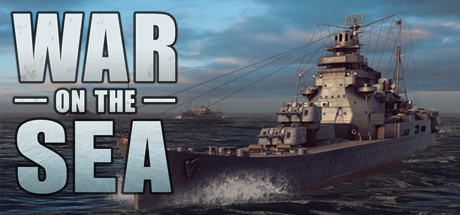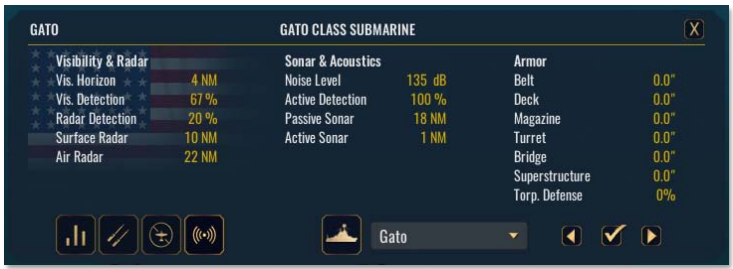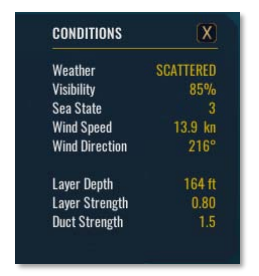War on the Sea – Sensors & Detection
Sensors & Detection
See Unit Viewer (F6) Sensors & Armor tab for information about a ship’s sensors and detection characteristics.
Visual (Vis.) Horizon:
How far a ship can see. Larger ships can see further since they are taller.
Large contacts can be seen “over” the visual horizon.
Visual (Vis.)/Radar Detection:
How easy a ship is to spot visually or with radar. Smaller ships are harder to see or detect with radar.
Surface/Air Radar:
How far the radar on this ship can detect ships or aircraft under the very BEST of conditions.
Noise Level:
How noisy the ship is in decibels. Louder ships are easier to detect with passive sonar.
Active Detection:
How easily the ship is detected by active sonar. A large hull makes a ship easier to detect with active sonar.
Passive/Active Sonar Strength:
How far the sonar models on this ship can detect the largest noisiest contacts under the very BEST of conditions.
ENVIRONMENTAL CONDITIONS
Use F5 or Menu button to open the Menu panel and view the environmental conditions for the current battle. The environmental conditions greatly impact the ability of units to detect each other by visual, radar and sonar as outlined below.
VISIBILITY
CONDITIONS
Base visibility is determined by 3 environmental conditions:
– Light level: Time of day determines lighting conditions.
– Weather: Heavier cloud cover reduces visibility while rain or snow dramatically decreases visibility to about 50%.
– Sea state: Rougher seas make it harder to detect a contact and strong winds whip up spray.
Base visibility is displayed as a percentage on the Menu panel and is applied to ALL visual detections outlined below.
SEA
Visual detection of a sea unit is modified by the following factors:
– Conditions: base visibility as determined by lighting, weather and sea state as mentioned above.
– Height of observer: Larger ships are higher can see farther than small ones. This is shown by the visual horizon value. High flying aircraft can see further.
– Size of contact: Large contacts can be seen more easily than small stealthy ones. Visibility is modified by the visual detection modifier of the contact.
– Contact Speed: Ships at high speed produce more funnel smoke and a larger wake, while stationary ships are harder to spot.
– Land: terrain within visual range behind a contact obscures it making it harder to detect
– Illumination: a contact on fire, firing guns which produce muzzle flashes or illuminated by star shells are easier to spot.
– Submerged: a submerged submarine is not visible, unless a periscope is raised.
AIR
Visual detection of an air unit is determined by:
– Conditions: base visibility as determined by lighting, weather and sea state as mentioned above.
– Size of contact: small fighter ~4,375 yd (4000m) to large bomber ~9,840 yd, (9,000m).
– Land: terrain within visual range behind a contact obscures it making it harder to detect.
RADAR
CONDITIONS
Base radar detection is modified by 2 environmental conditions as lighting does not impact radar detection.
– Sea state: Radar can “see” further than visual, but detection drops off more quickly with sea states above 6.
– Weather: Rain or snow scatters radio waves dramatically decreasing radar detection.
These environmental modifiers apply to all radar detections outlined below.
SEA
Radar detection of a sea unit is determined by:
– Conditions: base radar conditions as determined by weather and sea state as mentioned above.
– Strength of surface radar: listed under the Unit Viewer Sensors tab, Surface Radar indicates how far the system can spot a large sea contact under the best conditions.
– Size of contact: listed under the Unit Viewer Sensors tab, Radar Detection indicates the size modifier of the radar signature for a particular ship.
– Land: in radar range behind the target scatters radio waves, decreasing detection.
AIR
Radar detection of an air unit is determined by:
– Conditions: base radar conditions as determined by weather and sea state as mentioned above.
– Strength of air radar: listed under the Unit Viewer Sensors tab, Air Radar indicates how far the system can spot a large air contact under the best conditions.
– Size of contact: Large heavy bombers can be detected more easily than small fighters.
– Land: in radar range behind the contact scatters radio waves, decreasing detection.
– Altitude: Low flying aircraft are harder to detect than those at altitude.
RADAR DETECTION
Radar can detect contacts at much longer ranges than visual under the right conditions, however to do so the observer must emit radio waves.
These radio waves can be detected by other ships and give away the presence of the observer.
Any Sea unit using radar may be detected at a distance up to 80% the sum of the Surface Radar strengths of the emitting unit and receiving units.
SONAR
Sonar uses sound propagation through the ocean to detect submarines and ships. It cannot detect aircraft.
There are two types of sonar:
1) Passive: listens for the noise made by the target.
2) Active: sends out a loud “ping” and listens for a return echo from the target.
CONDITIONS
– Sea state: Rougher seas are louder making it harder to hear the contact.
– Rain or snow: Dramatically decreases sonar range by about 50%.
– Layer: A sudden drop in water temperature may generate a layer which reflects sound waves. Listening across a layer modifies sonar range by the Layer Strength value.
– Duct: A channel above the layer which improves sound propagation. Sound travels farther within the duct increasing sonar range by a factor of the Duct Strength value.
These environmental modifiers apply to all sonar detections outlined below.
Conditions are shown on the Menu panel (F5).
Layer Depth – if a layer is present, how deep is it. A submarine at depth below this level is considered under the layer.
Layer Strength – how strong the layer deflects sound waves. Detection range is multiplied by this factor.
Duct Strength – if a layer is present, by what factor the duct propagates sound. Detection range is multiplied by this factor.
Example: there is a layer 164 ft deep with strength of 0.8 with a duct above it of strength 1.5.
A submarine below 164 ft would detect ships at 0.8x normal range and can only be detected at 0.8x normal range.
A submarine above 164 ft (in the duct) could detect ships at 1.5x their normal range, but also be detected at 1.5x normal range!
PASSIVE SONAR
Passive sonar detection of a sea unit is determined by:
– Conditions: base sonar conditions as determined by weather, sea state and acoustics as mentioned above.
– Strength of passive sonar: listed under the Unit Viewer Sensors tab, Passive Sonar shows how far the system can hear a very noisy sea contact under the best conditions.
– Noise level of the target: Louder ships are easier to hear as shown by the Noise Level value of the Unit Viewer Sensors tab.
– Contact speed: Going faster makes more engine noise and flow noise of water against the hull making the contact easier to detect.
– Observer speed: Slow speeds are quieter making it easier to hear a contact above your own noise.
– Baffles: Ships and submarines have a blind spot behind them where sonar cannot hear a contact.
– Land: Land in front of a target makes it impossible to detect. Land or the seabed behind a target makes it harder to detect.
ACTIVE SONAR
Active sonar detection of a sea unit is determined by:
– Conditions: base sonar conditions as determined by weather, sea state and acoustics as mentioned above.
– Strength of active sonar: listed under the Unit Viewer Sensors tab, Active Sonar how far the system can hear a contact under the best conditions.
– Contact speed: Going faster creates more turbulence making the contact easier to detect.
– Observer speed: Slow speeds are quieter making it easier to hear a contact above your own noise.
– Baffles: Ships and submarines have a blind spot behind them where sonar cannot hear a target.
– Contact facing: A side on contact is much easier to detect than when front on as it provides a larger surface area to reflect the “ping”.
– Land: Land in front of a target makes it impossible to detect. Land or the seabed behind a target makes it harder to detect.







